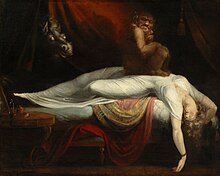Hypnopompia
Hypnopompia (also known as hypnopompic state) is the
Etymology
Hallucinations
Neurobiology
This section needs additional citations for verification. (November 2023) |
The objective difference between the subjective experiences of dreams and hypnopompic hallucinations emerges from a close look at the sleep cycle and its attendant brain activity: there are essentially two types of sleep,
It is precisely at this last point, though, that can cause hypnopompic hallucinations: occasionally during deep N.R.E.M., "transient patterns of neural activation in brainstem structures [resembling] micro-wake "fragments" can occur".[4] These have a two-fold effect: first, just as in R.E.M. sleep, these brain-stem fragments essentially activate the dream mechanism. Second, they catalyze a near-waking state. However, this is often not powerful enough to jar a person completely out of deep sleep, and so only the mind fully awakens, leaving the body trapped in the atonia of deep sleep. Another reason why hypnopompic hallucinations are often such horrible experiences is that micro-wake fragments appear to be related to serotonin and dopamine deficits—these deficits predispose a person to negative mental states, which likely causes the hallucinations to resemble bad dreams.[4]
Cultural manifestations

These mental experiences are indeed often deeply damaging: across cultures, the experience of hypnopompic hallucinations are strongly related to "visitations of spirits, demons or other grotesque creatures belonging to traditional folklore".
Similarly, subjects belonging to Yoruban-African diasporas report feeling as though they are being "ridden" by the evil manifestations of their versions of the African pantheon (ridden is the vernacular for possession by the gods, who are often referred to as "divine horsemen"). Some members of the Yoruba diaspora appear to conflate the cultural interpretation of the experience, referring to "being ridden by the witch". Japanese interpretations of the experience are often grouped under the heading of kanashibari, a term which literally means "bound in gold or metal" and derives from the name of an esoteric Buddhist technique for paralyzing enemies.[2]
Future research horizons
Owing to similarities between hypnopompic hallucinations and those experienced by people with dementia, Parkinson's and schizophrenia, significant progress is being made on understanding the neurobiological basis of this experience. Researchers have identified "a common neurofunctional substrate [which] points to a shared pattern of brain activation" underlying elements of schizophrenic delusions and these near-waking hallucinations: "with regional grey matter blood flow values being maximally increased in right parietal-occipital regions" during hypnagogic hallucinations and many schizoid episodes. Thus,[how?] such painful near-waking experiences could be rendered obsolete.[how?][2]
See also
Notes
- PMID 36017720.
- ^ ISBN 978-1-4419-0853-7.
- ISBN 978-0-323-24288-2.
- ^ PMID 27358492.
References
- T. Balkin, A. Braun, et al., "The process of awakening: A PET study of regional brain activity patterns mediating the reestablishment of alertness and consciousness," Brain, vol. 125, 2002, pp. 2308–19.
- P. Tassi and A. Muzet, "Sleep inertia," Sleep Medicine Review, vol. 4, no. 4, 2000, pp. 341–53.
- Warren, Jeff (2007). "The Hypnopompic". The Head Trip: Adventures on the Wheel of Consciousness. Random House. ISBN 978-0-679-31408-0.
